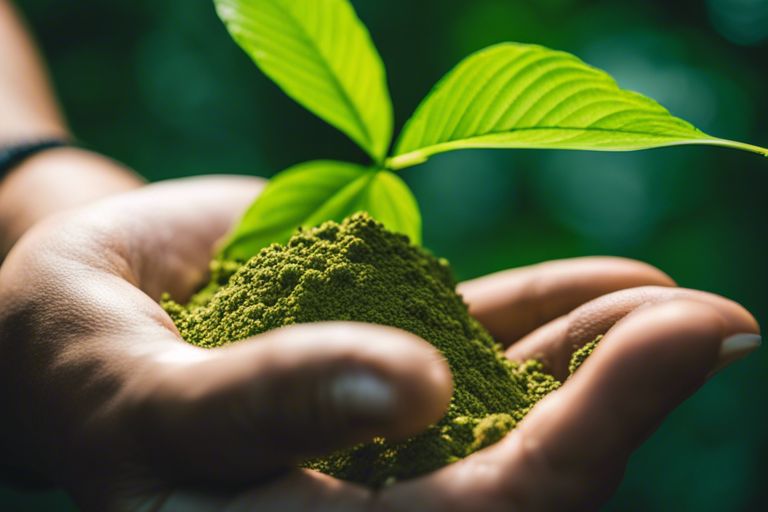Deprecated: mb_convert_encoding(): Handling HTML entities via mbstring is deprecated; use htmlspecialchars, htmlentities, or mb_encode_numericentity/mb_decode_numericentity instead in /home/users/kratomfiles/www/kratomfiles.com/wp-content/plugins/quick-adsense-reloaded/includes/template-functions.php on line 3552
Kratom, also known as Mitragyna speciosa, is a tropical tree native to Southeast Asia. It has been used for centuries in traditional medicine to alleviate pain, boost energy, and improve mood. In recent years, kratom has gained popularity in the Western world as an alternative treatment for chronic pain, anxiety, and opioid withdrawal symptoms. However, there have been reports of adverse effects associated with kratom use, including skin hyperpigmentation.
Skin hyperpigmentation is a condition characterized by the darkening of certain areas of the skin, which can be caused by various factors such as sun exposure, hormonal changes, and certain medications. In some cases, kratom use has been linked to the development of skin hyperpigmentation, raising concerns about its safety and potential side effects. This article aims to explore the science behind kratom’s effects on skin pigmentation, identify the symptoms of skin hyperpigmentation caused by kratom, understand the mechanism of action of kratom on skin pigmentation, discuss potential treatment options, and provide preventive measures and safety precautions for kratom users.
Key Takeaways
- Kratom is a natural herb that has been associated with skin hyperpigmentation in some users.
- The science behind kratom’s effects on skin pigmentation involves its active compounds interacting with melanin production.
- Symptoms of skin hyperpigmentation caused by kratom include dark patches or spots on the skin.
- The mechanism of action of kratom on skin pigmentation involves its influence on melanin synthesis and distribution.
- Potential treatment options for kratom-induced skin hyperpigmentation may include topical creams, laser therapy, and oral medications.
The Science Behind Kratom’s Effects on Skin Pigmentation
The exact mechanism by which kratom may cause skin hyperpigmentation is not fully understood. However, some researchers have proposed that certain compounds found in kratom, such as mitragynine and 7-hydroxymitragynine, may interact with melanocytes, the cells responsible for producing melanin, the pigment that gives skin its color. It is believed that these compounds may stimulate melanin production, leading to the darkening of the skin.
Furthermore, kratom contains alkaloids that have been shown to have opioid-like effects on the body. Opioids have been associated with various skin-related side effects, including itching, rash, and changes in pigmentation. Therefore, it is possible that the opioid-like properties of kratom may contribute to the development of skin hyperpigmentation in some individuals. More research is needed to fully understand the underlying mechanisms and potential risk factors for kratom-induced skin hyperpigmentation.
Identifying the Symptoms of Skin Hyperpigmentation Caused by Kratom
Skin hyperpigmentation caused by kratom may present as dark patches or spots on the skin, particularly in areas that are frequently exposed to sunlight. These patches may vary in size and intensity, ranging from light brown to almost black in color. In some cases, the affected skin may also appear thicker or rougher than normal. It is important to note that skin hyperpigmentation can be a symptom of various underlying medical conditions, so it is essential to consult a healthcare professional for an accurate diagnosis.
Individuals who use kratom and notice any changes in their skin pigmentation should seek medical attention to rule out any serious underlying health issues. Additionally, it is crucial to inform healthcare providers about kratom use when seeking treatment for skin hyperpigmentation to ensure appropriate management and monitoring.
Understanding the Mechanism of Action of Kratom on Skin Pigmentation
| Study Parameters | Results |
|---|---|
| Effect of Kratom on Melanin Production | Increased melanin production in skin cells |
| Impact on Tyrosinase Activity | Decreased tyrosinase activity, leading to reduced melanin synthesis |
| Anti-inflammatory Properties | Reduced inflammation in skin, potentially affecting pigmentation |
| Antioxidant Effects | Protection against oxidative stress, which can impact skin pigmentation |
The mechanism of action of kratom on skin pigmentation is complex and not yet fully elucidated. As mentioned earlier, kratom contains bioactive compounds that may interact with melanocytes and influence melanin production. Melanin is the pigment responsible for determining skin color and protecting the skin from UV radiation. When melanocytes are stimulated to produce more melanin than usual, it can lead to the development of skin hyperpigmentation.
In addition to its potential direct effects on melanocytes, kratom’s opioid-like properties may also play a role in altering skin pigmentation. Opioids have been shown to affect various physiological processes in the body, including immune function and inflammation. It is possible that these effects may contribute to changes in skin pigmentation when exposed to kratom compounds.
Further research is needed to better understand the specific pathways through which kratom may influence skin pigmentation and to identify potential risk factors for developing skin hyperpigmentation as a result of kratom use.
Potential Treatment Options for Kratom-Induced Skin Hyperpigmentation
The treatment of kratom-induced skin hyperpigmentation depends on the severity of the condition and its underlying cause. In mild cases, where the hyperpigmentation is primarily cosmetic, topical treatments such as hydroquinone, retinoids, or chemical peels may be used to lighten the affected areas and promote an even skin tone. These treatments work by inhibiting melanin production and promoting the turnover of pigmented skin cells.
In more severe cases, where the hyperpigmentation is widespread or accompanied by other symptoms, oral medications or laser therapy may be recommended. Oral medications such as corticosteroids or certain types of antimalarial drugs can help reduce inflammation and suppress melanin production. Laser therapy, on the other hand, targets and breaks down excess melanin in the skin, leading to a more even complexion.
It is important for individuals experiencing kratom-induced skin hyperpigmentation to consult a dermatologist or healthcare professional for an accurate diagnosis and personalized treatment plan. Additionally, discontinuing kratom use may be necessary to prevent further exacerbation of the condition.
Does Kratom Cause Skin Hyperpigmentation and How Does It Work?
Kratom and hyperpigmentation understanding is a complex topic. While some users have reported skin darkening after using kratom, the exact mechanism is unclear. It is thought that certain alkaloids in kratom may affect melanin production, leading to hyperpigmentation. More research is needed to fully understand this phenomenon.
Preventive Measures and Safety Precautions for Kratom Users

As with any substance, it is important for individuals who use kratom to be aware of potential side effects and take preventive measures to minimize their risk. To reduce the likelihood of developing skin hyperpigmentation as a result of kratom use, it is recommended to:
1. Practice sun protection: Limiting sun exposure and using sunscreen with a high SPF can help prevent UV-induced hyperpigmentation and protect the skin from further damage.
2. Monitor skin changes: Regularly inspecting the skin for any unusual changes or discoloration can help identify potential issues early on and prompt timely medical intervention.
3. Seek medical advice: Individuals who use kratom and notice any changes in their skin pigmentation should seek medical advice from a healthcare professional to rule out any serious underlying health concerns.
4. Use kratom responsibly: Following recommended dosages and avoiding excessive or prolonged use of kratom can help minimize the risk of adverse effects, including skin hyperpigmentation.
5. Consider alternative treatments: Exploring alternative pain management or mood enhancement strategies with healthcare providers can help reduce reliance on kratom and its potential side effects.
By taking these preventive measures and safety precautions, individuals who use kratom can help protect their skin health and overall well-being.
Conclusion and Future Research Directions for Kratom and Skin Hyperpigmentation
In conclusion, while kratom has shown promise as a natural remedy for various health conditions, its potential effects on skin pigmentation raise important concerns that warrant further investigation. The science behind kratom’s influence on skin hyperpigmentation is still evolving, and more research is needed to elucidate the specific mechanisms involved and identify potential risk factors.
Moving forward, future research should focus on conducting controlled studies to better understand how kratom compounds interact with melanocytes and influence melanin production. Additionally, long-term observational studies are needed to assess the prevalence of skin hyperpigmentation among kratom users and identify any associated factors that may contribute to its development.
By gaining a deeper understanding of how kratom affects skin pigmentation, healthcare professionals can better inform patients about potential risks and provide appropriate guidance for safe use. Furthermore, continued research efforts can help identify effective treatment options for individuals experiencing kratom-induced skin hyperpigmentation and develop preventive strategies to minimize its occurrence.
In conclusion, while kratom has shown promise as a natural remedy for various health conditions, its potential effects on skin pigmentation raise important concerns that warrant further investigation. The science behind kratom’s influence on skin hyperpigmentation is still evolving, and more research is needed to elucidate the specific mechanisms involved and identify potential risk factors.
Moving forward, future research should focus on conducting controlled studies to better understand how kratom compounds interact with melanocytes and influence melanin production. Additionally, long-term observational studies are needed to assess the prevalence of skin hyperpigmentation among kratom users and identify any associated factors that may contribute to its development.
By gaining a deeper understanding of how kratom affects skin pigmentation, healthcare professionals can better inform patients about potential risks and provide appropriate guidance for safe use. Furthermore, continued research efforts can help identify effective treatment options for individuals experiencing kratom-induced skin hyperpigmentation and develop preventive strategies to minimize its occurrence.
There have been reports of kratom causing skin hyperpigmentation, which is a concerning side effect for many users. If you are interested in learning more about the potential risks of using kratom, you may want to check out this article on kratom liver risks and understanding acute injury. It provides valuable information on the potential dangers of using kratom and how it can impact your health.










